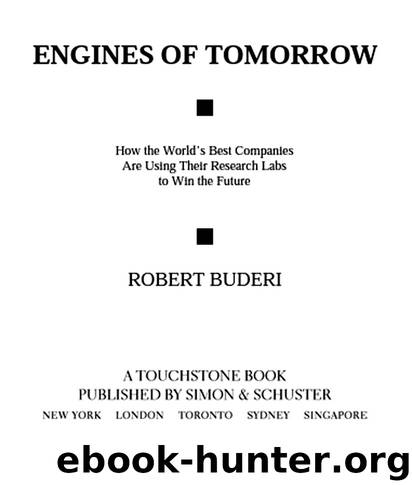Engines of Tomorrow by Robert Buderi

Author:Robert Buderi
Language: eng
Format: epub
Publisher: A TOUCHSTONE BOOK
Published: 2000-07-15T00:00:00+00:00
The existence of two optical states—one highly refractive, the other not—began to sound to Linke like the basis for a storage medium. After all, typical disk drives rely on two magnetic states, or orientations, to represent the ones or zeros of binary data. The big difference with the DX center was that these bits theoretically could be written, stored, and read with lasers by selectively changing or detecting the refractive index associated with dopant atoms. More important, since photons don’t interact with each other, data could be distributed throughout the crystal—increasing geometrically the volume of information a semiconductor could hold. As Linke puts it, “Other storage media are all planar. Everything has to be written on the surface—so you waste a lot of volume.” If that weren’t incentive enough, he adds, putting so much information in a small space makes for extremely rapid access.
In October 1993, Linke conducted an experiment that proved his hunches were right on target. Encouraged, he began studying optical storage more intensely. It was not a new concept. But apparently no one had explored a DX-based approach. Instead, most existing studies focused on so-called photorefractive materials like lithium niobate. While offering some promise, however, these compounds were plagued by shortcomings Linke felt limited their capabilities.
Linke, though, had his own materials problem. In order to exhibit the DX effect, his samples had to be super-cooled to around 50 degrees Kelvin. Since that represented an extremely expensive undertaking, the NEC team went hunting for alternatives. Members explored a variety of materials—with limited success—until around 1996 Chadi met up with Alex Ryskin, a solid-state physicist at the Vasilov State Optical Institute in St. Petersburg. Ryskin had spent his professional life studying cadmium fluoride. He told Chadi that when doped with indium or gallium it exhibited a DX center that was stable at around 180 K. While still a far cry from room temperature at 290 K, that represented the breakthrough Linke needed—sparking a fruitful collaboration with the Russian scientist and paving the way for practical experiments later that year.
Under Linke’s scheme, laser light is split into two paths: the signal beam carrying in data and the reference beam needed to “write” the information into the crystal. Before entering the crystal, the signal beam passes through a small glass mask—much like those used for photolithographic etching of integrated circuits—that holds a mock-up of the data to be stored. This mask is laced with intricate patterns of metal. Therefore, while the laser beam passes unencumbered through the clear portions of the glass, it is blocked by those containing metal. The result is a complicated tapestry of light and dark—ones and zeroes—that rides the signal beam into the crystal.
At this point, classic holography takes over. The interference between the signal and reference beams forms a stationary pattern of bright and dark regions throughout the crystal’s volume. Since the refractive index is lowered only in regions struck by the light—and stays low even after the signal beam is turned off—what remains is essentially a recording of the mask data.
Download
This site does not store any files on its server. We only index and link to content provided by other sites. Please contact the content providers to delete copyright contents if any and email us, we'll remove relevant links or contents immediately.
Hit Refresh by Satya Nadella(9083)
The Compound Effect by Darren Hardy(8870)
Change Your Questions, Change Your Life by Marilee Adams(7684)
Nudge - Improving Decisions about Health, Wealth, and Happiness by Thaler Sunstein(7657)
The Black Swan by Nassim Nicholas Taleb(7056)
Deep Work by Cal Newport(6966)
Rich Dad Poor Dad by Robert T. Kiyosaki(6513)
Daring Greatly by Brene Brown(6473)
Principles: Life and Work by Ray Dalio(6296)
Playing to Win_ How Strategy Really Works by A.G. Lafley & Roger L. Martin(6083)
Man-made Catastrophes and Risk Information Concealment by Dmitry Chernov & Didier Sornette(5956)
Digital Minimalism by Cal Newport;(5704)
Big Magic: Creative Living Beyond Fear by Elizabeth Gilbert(5677)
The Myth of the Strong Leader by Archie Brown(5457)
The Slight Edge by Jeff Olson(5376)
Discipline Equals Freedom by Jocko Willink(5336)
The Motivation Myth by Jeff Haden(5175)
The Laws of Human Nature by Robert Greene(5080)
Stone's Rules by Roger Stone(5052)
